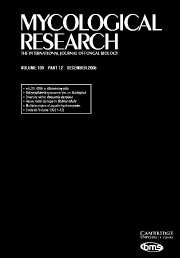Crossref Citations
This article has been cited by the following publications. This list is generated based on data provided by
Crossref.
Kasiamdari, Rina S.
Smith, Sarah E.
Scott, Eileen S.
and
Smith, Frank A.
2002.
Identification of binucleate Rhizoctonia as a contaminant in pot cultures of arbuscular mycorrhizal fungi and development of a PCR-based method of detection.
Mycological Research,
Vol. 106,
Issue. 12,
p.
1417.
Guidot, Alice
Debaud, Jean-Claude
and
Marmeisse, Roland
2002.
Spatial distribution of the below-ground mycelia of an ectomycorrhizal fungus inferred from specific quantification of its DNA in soil samples.
FEMS Microbiology Ecology,
Vol. 42,
Issue. 3,
p.
477.
Taylor, G.
Wang, X.
and
Jabaji-Hare, S. H.
2003.
Detection of the mycoparasiteStachybotrys elegans, using primers with sequence- characterized amplification regions in conventional and real-time PCR.
Canadian Journal of Plant Pathology,
Vol. 25,
Issue. 1,
p.
49.
Dauch, A.L.
Watson, A.K.
and
Jabaji-Hare, S.H.
2003.
Detection of the biocontrol agent Colletotrichum coccodes (183088) from the target weed velvetleaf and from soil by strain-specific PCR markers.
Journal of Microbiological Methods,
Vol. 55,
Issue. 1,
p.
51.
Grönberg, Henrietta
Paulin, Lars
and
Sen, Robin
2003.
ITS probe development for specific detection of Rhizoctonia spp. and Suillus bovinus based on Southern blot and liquid hybridization-fragment length polymorphism.
Mycological Research,
Vol. 107,
Issue. 4,
p.
428.
Morissette, Danielle C.
Driscoll, Brian T.
and
Jabaji-Hare, Suha
2003.
Molecular cloning, characterization, and expression of a cDNA encoding an endochitinase gene from the mycoparasite Stachybotrys elegans.
Fungal Genetics and Biology,
Vol. 39,
Issue. 3,
p.
276.
Dodd, Sarah L.
Hill, Robert A.
and
Stewart, Alison
2004.
A duplex-PCR bioassay to detect a Trichoderma virens biocontrol isolate in non-sterile soil.
Soil Biology and Biochemistry,
Vol. 36,
Issue. 12,
p.
1955.
Herdina
Neate, Stephen
Jabaji-Hare, Suha
and
Ophel-Keller, Kathy
2004.
Persistence of DNA of Gaeumannomyces graminis var. tritici in soil as measured by a DNA-based assay.
FEMS Microbiology Ecology,
Vol. 47,
Issue. 2,
p.
143.
Sharon, Michal
Sneh, Baruch
Kuninaga, Shiro
and
Hyakumachi, Mitsuro
2006.
The advancing identification and classification of Rhizoctonia spp. using molecular and biotechnological methods compared with the classical anastomosis grouping.
Mycoscience,
Vol. 47,
Issue. 6,
p.
299.
Grosch, R.
Schneider, J.H.M.
Peth, A.
Waschke, A.
Franken, P.
Kofoet, A.
and
Jabaji-Hare, S.H.
2007.
Development of a specific PCR assay for the detection of Rhizoctonia solani AG 1-IB using SCAR primers.
Journal of Applied Microbiology,
Vol. 102,
Issue. 3,
p.
806.
Sharon, Michal
Freeman, Stanley
Kuninaga, Shiro
and
Sneh, Baruch
2007.
Genetic diversity, anastomosis groups and virulence of Rhizoctonia spp. from strawberry.
European Journal of Plant Pathology,
Vol. 117,
Issue. 3,
p.
247.
Liu, J.H.
Gao, L.
Liu, T.G.
and
Chen, W.Q.
2009.
Development of a sequence-characterized amplified region marker for diagnosis of dwarf bunt of wheat and detection ofTilletia controversaKühn.
Letters in Applied Microbiology,
Vol. 49,
Issue. 2,
p.
235.
Ayala-Zermeño, M.A.
Reyes-Montes, M.R.
Arroyo-Vázquez, E.
Calderón-Ezquerro, M.C.
Mier, T.
Robledo-Retana, T.
and
Toriello, C.
2011.
AnIsaria fumosoroseaSCAR marker for evaluation of soil, insect, and airborne samples.
Biocontrol Science and Technology,
Vol. 21,
Issue. 9,
p.
1091.
Reddy, J. Madhusudhana
Raoof, M. A.
and
Ulaganathan, K.
2012.
Development of specific markers for identification of Indian isolates of Fusarium oxysporum f.sp. ricini.
European Journal of Plant Pathology,
Vol. 134,
Issue. 4,
p.
713.
Faisal, Peeran Mohammed
Prema, Ranjitham
Nagendran, Krishnan
Gandhi, Kathikeyan
Raguchander, Thiruvengadam
and
Prabakar, Kuppusamy
2013.
WITHDRAWN: A specific and sensitive method for the detection of Colletotrichum musae in banana fruit.
Revista Iberoamericana de Micología,
Amaradasa, Bimal S.
Lakshman, Dilip
Horvath, Brandon J.
and
Amundsen, Keenan L.
2014.
Development of SCAR markers and UP-PCR cross-hybridization method for specific detection of four major subgroups of Rhizoctonia from infected turfgrasses.
Mycologia,
Vol. 106,
Issue. 1,
p.
163.
Liu, Na
Jiang, Shijun
Feng, Songli
Shang, Wenyan
Xing, Guozhen
Qiu, Rui
Li, Chengjun
Li, Shujun
and
Zheng, Wenming
2019.
A Duplex PCR Assay for Rapid Detection of Phytophthora nicotianae and Thielaviopsis basicola.
The Plant Pathology Journal,
Vol. 35,
Issue. 2,
p.
172.
Ambreetha, Sakthivel
and
Balachandar, Dananjeyan
2023.
SCAR marker: A potential tool for authentication of agriculturally important microorganisms.
Journal of Basic Microbiology,
Vol. 63,
Issue. 1,
p.
4.

